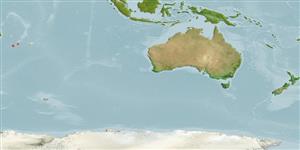Klassifizierung / Names
Namen | Synonyme | Catalog of Fishes(Gattung, Arten) | ITIS | CoL | WoRMS | Cloffa
>
Blenniiformes (Blennies) >
Blenniidae (Combtooth blennies) > Salariinae
Etymology: Dodekablennos: Greek, dodeka = twelve + Greek, blennos = mucus (Ref. 45335); also, meaning "blenny"; in reference to the 12 dorsal-fin spines and pectoral-fin rays (Ref. 69212).
Environment: milieu / climate zone / depth range / distribution range
Ökologie
seewasser demersal; tiefenbereich 0 - 2 m (Ref. 33390). Tropical
Western Indian Ocean: Reunion and Mauritius.
Size / Gewicht / Alter
Maturity: Lm ? range ? - ? cm
Kurzbeschreibung
Morphologie | Morphometrie
Rückenflossenstacheln (insgesamt): 12; Rückenflossenweichstrahlen (insgesamt): 19-20; Afterflossenstacheln 2; Afterflossenweichstrahlen: 21. With 12 pectoral-fin rays; with no nape and orbital cirri; typically with fewer than 65 teeth in each jaw; with vomerine teeth; 12 dorsal-fin spines and with only 2-6 branched caudal-fin rays; terminal anal-fin ray unbound by membrane to the caudal peduncle. Males possessing a fleshy, blade-like crest on head. Color pattern based on preserved specimens: dusky head, ventrally paler with slightly dusky chevron in smaller specimens or a cross mark on the largest specimen; dusky bar continuing ventrally beginning from midventral margin of orbit across lip, posteriorly alternated by paler area from diffuse dusky bar continuing ventrally from just posterior to eye across corner of mouth to ventral surface of head, contributing to formation of dusky chevron; pale upper lip and male crest with dusky spots; lateral side of body with 7-8 dark dusky bands interspersed with pale areas; anteriormost band dorsally diffused; all bands continuing onto dorsal fin; posterior bands typically dorsally forked in males and both dorsally and ventrally in females; posteriormost band expanded in largest specimen, continuing ventroposteriorly well onto caudal fin and joining dusky stripe along ventral margin of fin; dorsal-fin spines and rays variably dusky; males with distal intensely black spots on each of the first three interradial membranes; female lacking black spots; anal fin dusky and submarginally darker; spine and ray tips without pigmentation (Ref. 69212).
Found in tide pools (Ref. 33390). Oviparous. Eggs are demersal and adhesive (Ref. 205), and are attached to the substrate via a filamentous, adhesive pad or pedestal (Ref. 94114). Larvae are planktonic, often found in shallow, coastal waters (Ref. 94114).
Life cycle and mating behavior
Geschlechtsreife | Fortpflanzung | Ablaichen | Eier | Fecundity | Larven
Oviparous, distinct pairing (Ref. 205).
Fricke, R., 1999. Fishes of the Mascarene Islands (Réunion, Mauritius, Rodriguez): an annotated checklist, with descriptions of new species. Koeltz Scientific Books, Koenigstein, Theses Zoologicae, Vol. 31:759 p. (Ref. 33390)
IUCN Rote Liste Status (Ref. 130435)
Bedrohung für Menschen
Harmless
Nutzung durch Menschen
Mehr Information
NamenSynonymeMetabolismusRäuberÖkotoxikologieFortpflanzungGeschlechtsreifeAblaichenSpawning aggregationFecundityEierEientwicklung
Alter/GrößeWachstumLänge-GewichtLänge-LängeLängenhäufigkeitenMorphometrieMorphologieLarvenLarven Pop.Dyn.RekrutierungDichteBRUVS
ReferenzenAquakulturAquakultur ProfilZuchtlinienGenetikElectrophoresesVererbbarkeitKrankheitenVerarbeitungNutrientsMass conversion
PartnerBilderStamps, Coins Misc.LauteCiguateraGeschwindigkeitSchwimmstilKiemenoberflächeOtolithsGehirngrößeSehfähigkeit
Tools
Zusatzinformationen
Download XML
Internet Quellen
Estimates based on models
Preferred temperature (Ref.
123201): 25.4 - 27.5, mean 25.6 °C (based on 9 cells).
Phylogenetic diversity index (Ref.
82804): PD
50 = 1.0000 [Uniqueness, from 0.5 = low to 2.0 = high].
Bayesian length-weight: a=0.01000 (0.00244 - 0.04107), b=3.04 (2.81 - 3.27), in cm total length, based on all LWR estimates for this body shape (Ref.
93245).
Widerstandsfähigkeit (Ref.
120179): hoch, Verdopplung der Population dauert weniger als 15 Monate. (Preliminary K or Fecundity.).
Fishing Vulnerability (Ref.
59153): Low vulnerability (10 of 100).
